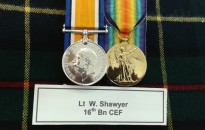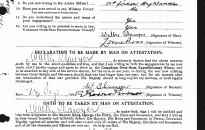Overview:
Born on 31 October 1890, Walter Shawyer would migrate to Victoria, British Columbia and become an officer in the Victoria Police Department and member of the 50th (Gordon Highlanders) Regiment prior to 1914.
He would be among the First Contingent’s soldiers to survive the war and would serve in the 16th Canadian Expeditionary Force Battalion, the 67th Canadian Pioneer Battalion, the 4th Pioneer Battalion, 54th C.E.F. Battalion, and later the reserve units in England. He would be promoted several times throughout his career in the Canadian Expeditionary Force until he was “struck-off-strength” on 19 September 1919.
Before Deployment Overseas
Walter Shawyer was born in Soberton, Southampton Bay, England on 31 October 1890.[1] He would eventually settle in Victoria, become a police officer, and serve with the active militia in the local 50th (Gordon Highlanders) Regiment. When the Great War broke out, he and five other officers in the VicPD enlisted for military service; they all served in the same battalion except for Charles Taylor who served in the Royal Irish Rifles. They took a train to Valcartier, Quebec where he was deemed “fit” for military service on 23 September 1914.[2]
His medical record states he was 6 feet tall, had dark complexion, brown eyes, and dark brown hair.[3] He was a member of the Church of England.
Overseas Service
Shawyer initially served with the 16th C.E.F. Battalion and arrived in France on 9 February 1915.[4]

He was promoted to “corporal” on 12 April 1915. Corporal Shawyer fought at St-Julien, a part of the Second Battle of Ypres, and was wounded on 22 April 1915.[5] Three days later he was evacuated and arrived in England on 26 April 1915 where he would serve with the Reserve Units. However, he was reported missing although later recovered from 22-28 May 1915.[6]
Corporal Shawyer was reassigned to the 67th Canadian Pioneer Battalion, with men drawn from Victoria among others, on 10 June 1916.[7] He was promoted to “temporary lieutenant” on 22 July 1916 and served with the 67th in France from 15 August to 29 October 1916. He was injured on 25 October 1916, likely during the Battle of the Somme (July to November 1916).[8]
After the Battle of the Somme, Lieutenant Shawyer continued to serve in the 67th Canadian Pioneer Battalion until it was redesignated the 4th Canadian Pioneer Battalion under Colonel Lorne Ross with its men mobilized and recruited in Victoria.[9] It is likely he fought in the Battle of Vimy Ridge, part of the Battle of Arras, in 1917 as his record states he served from 2 February to 25 May 1917 with the battalion[10] until it was disbanded. The battalion was disbanded in April 1917 and he was transferred to the 54th Battalion until 25 July 1917 when he, and likely his unit, was sent to England as reserves for the duration of the war.[11] He was “struck-off-service” on 19 September 1919.[12]

Written by Joseph Yuson
References
[1] Shawyer, Walter. Service No. 28671. “Attestation Paper,” 1. Victoria, Canada: University of Victoria Special Collections. RG 150, Accession 1992-93/166, Box 8828-16.
[2] Shawyer, “Attestation Paper,” 2.
[3] Ibid.
[4] Lieutenant-Colonel H. M. Urquhart, D.S.O., M.C., A.D. The History of the 16th Battalion (The Canadian Scottish) Canadian Expeditionary Force in the Great War, 1914-1919. Toronto: MacMillan Company of Canada, 1932, 777.
[5] Ibid.
[6] Memo Card of Walter Shawyer.
[7] Urquhart, History of the 16th Battalion, 777.
[8] Ibid.
[9] Library and Archives Canada. “4th Canadian Pioneer Battalion (formerly 67th Battalion),” in Guide to Sources Relating to Units of the Canadian Expeditionary Force: Pioneer Battalions, 29.
[10] Ibid.
[11] Urquhart, History of the 16th Battalion, 777.
[12] Ibid.

